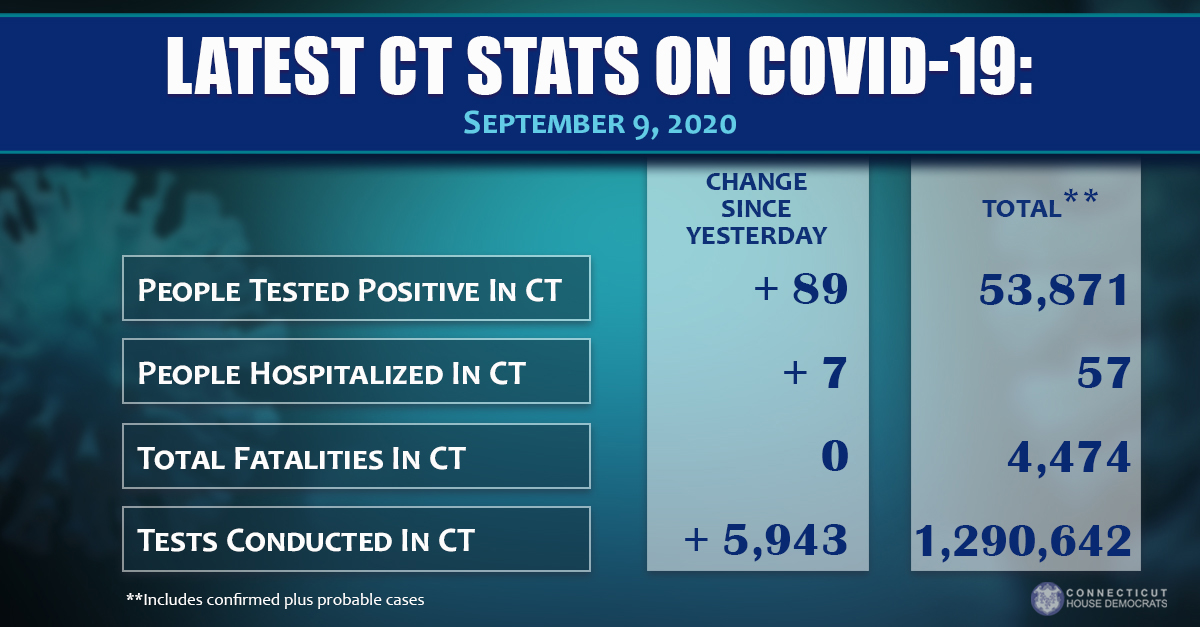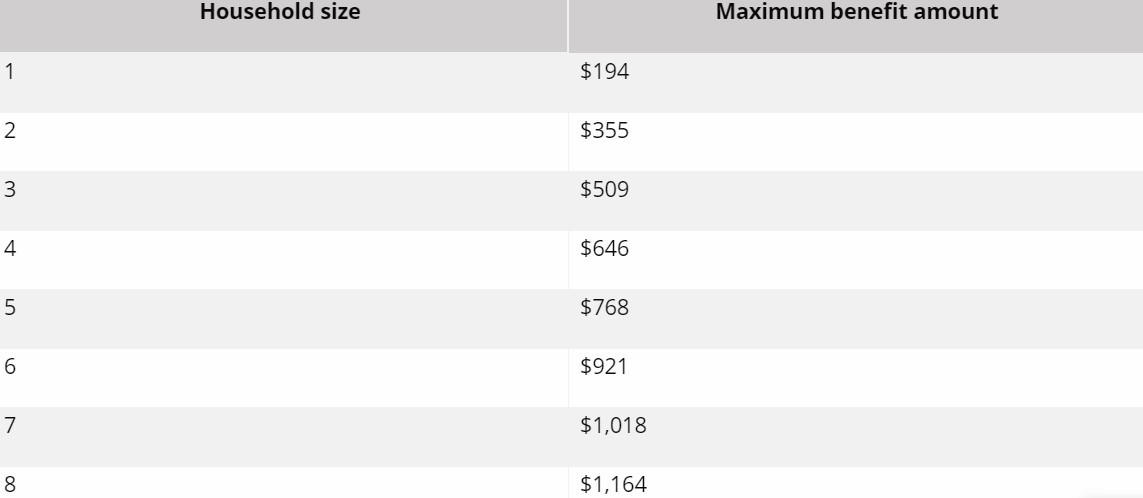9/9 update
September 9, 2020Here is the September 9, 2020 update from Governor Ned Lamont regarding the state's coronavirus response efforts.
For county and specific information including the cumulative number of COVID-19 cases by town please click here.

For several additional graphs and tables containing more data, including a list of cases in every municipality, visit ct.gov/coronavirus and click the link that is labeled, “COVID-19 Data Tracker.”
Connecticut approved for two additional weeks of lost wages assistance; Claimant certification begins within a week
Connecticut Department of Labor (CTDOL) Commissioner Kurt Westby today announced that the State of Connecticut has been approved for an additional two weeks of Lost Wages Assistance supplemental benefits. Lost Wages Assistance is the new federal program funded by $44 billion in Stafford Act disaster relief. It will provide an additional $300 per week for any claimant who has a weekly benefit of at least $100 (including the dependency allowance) and who has become unemployed or partially unemployed due to COVID-19.
“This program will be a significant help to a lot of Connecticut residents who need assistance,” Commissioner Westby said. “With five weeks of benefits available, Lost Wages Assistance can take some financial pressure off claimants, but it is only a temporary program and expires when the FEMA funding is exhausted. I join Governor Lamont and our Congressional delegation in urging a more permanent solution for the workforce, which is still reeling from COVID-19.”
Existing Pandemic Unemployment Assistance (PUA) claimants have already self-certified and do not need to do anything to receive the additional benefit. New unemployment claimants and existing state and extended benefits claimants who are required to self-certify are notified by letter or email that they are eligible and may self-certify when the program is open. CTDOL is currently testing self-certification and opening the program to small groups of people over the course of the next few
days. Payments will be disbursed in mid-September when the self-certification testing is complete and widely available to all.
To self-certify:
- Claimants log into their unemployment account, where the account main page offers a new option in the menu “Certify for Lost Wages Assistance.”
- Once a claimant has clicked on the button, a new screen will ask them to certify that their unemployment or underemployment is due to COVID-19.
- The claimant then confirms their submission and has completed the process.
Federal eligibility guidelines include:
- Recipients of at least $100 per week, including the dependency allowance, of any of the following benefits for the week they are seeking unemployment benefits;
- Claimants receiving unemployment compensation, including state and federal workers and former service members, as well as those receiving Pandemic Unemployment Assistance, Pandemic Emergency Unemployment Compensation, Extended Benefits, or High Extended Benefits;
- Claimants who are part of the Shared Work Program; and
- Workers with a Trade Readjustment Allowance.
A total of five weeks of Lost Wages Assistance will be paid in addition to regular unemployment weekly benefits and will be retroactive to the claim week beginning July 26, 2020. It will also be available for claim weeks beginning August 2, 9, 16, and 23, 2020. Claimants will receive the supplemental benefit in several payments; the first payment of $300 will be issued mid-September, with the remainder of retroactive payments following in two or three separate payments.
FEMA will terminate the program once available federal funding is exhausted or if the federal government passes legislation that replaces the program. The program is expected to provide $375 million in additional unemployment benefits to Connecticut claimants.
CTDOL estimates that about 250,000 claimants will be eligible for the funding. The agency will continue to release updates as they become available on the CTDOL Federal Supplements webpage
and send them directly to anyone who signs up for “Info to your Inbox” on the agency’s homepage.
FEMA extends approval of non-congregate sheltering program through October 1
The Federal Emergency Management Agency (FEMA) has approved a 30-day extension of the non-congregate sheltering authorization under the FEMA Public Assistance program through October 1, 2020. This program, which was initially approved in March, provides non-congregate housing to certain high-risk individuals, including those who have COVID-19 or have been in contact with individuals who have the virus. It provides the state and its municipalities with a 75 percent reimbursement of all eligible costs associated with this housing. The program covers non-congregate housing for:
- Those at high risk of exposure in public service;
- Individuals in at-risk facilities, such as group homes, nursing homes, long-term care sites, and alternative care facilities;
- First responders and health care workers who have been exposed and cannot return home;
- Homeless individuals in congregate shelters; and
- Individuals in domestic violence shelters.
Connecticut’s implementation of this program has been highlighted as a best practice by the National Low-Income Housing Coalition.
Additional SNAP benefits coming September 17 to nearly 109,600 households in Connecticut
The Connecticut Department of Social Services will provide over $16.5 million in Emergency Supplemental Nutrition Assistance (SNAP) Benefits to nearly half of Connecticut’s SNAP participants on Thursday, September 17, 2020 – adding to the $100.6 million in emergency benefits disbursed in April, May, June, July, and August.
Authorized by the federal Families First Coronavirus Response Act of 2020, the extra food benefits will go to nearly 109,600 households that are not currently receiving the maximum benefits allowed for their household size. This means that all households enrolled in SNAP will receive the maximum food benefit allowable for their household size, even if they are not usually eligible for the maximum benefit.
Specifically:
- The Department of Social Services reports that nearly 109,600 of 222,119 SNAP-participating households statewide will receive the emergency benefits in September.
- With this additional $16.5 million allocation by the U.S. Department of Agriculture’s Food and Nutrition Service, emergency benefits are totaling over $117.4 million in additional SNAP assistance statewide during April, May, June, July, August, and September with commensurate spending in the food economy.
- The average emergency benefit amount a household will see in its electronic benefits transfer (EBT) card on September 17 is $153.
- All participating households also received their normal SNAP benefits on the first three days of each month as they normally do, according to last name.
Emergency benefits allowed the household’s SNAP benefit to increase to the maximum allotment for a household of that size as follows

Each additional person: add $146
For example, if a household of two normally received $255 of SNAP benefits in September, $100 would bring this household up to the maximum benefit for its size. The household will receive a $100 emergency benefit on September 17.
For additional information about SNAP, visit www.ct.gov/SNAP.
Governor Lamont encourages residents to sign up for the state’s CTAlert notification system
Governor Lamont is encouraging Connecticut residents to sign up for CTAlert, the state’s emergency alert system, which provides text message notifications to users. To subscribe, text the keyword COVIDCT to 888-777.
Providing information to Connecticut residents
For the most up-to-date information from the State of Connecticut on COVID-19, including an FAQ and other guidance and resources, residents are encouraged to visit ct.gov/coronavirus.





